
|
|||
|
Jeep FAQ How-To Articles Quick Reference Product Reviews My Buildup Random Home |
Tired of seeing that volt gauge drop to nothing on those hard winch pulls? Worried your Jeep won't started after those long winch pulls? Perhaps its time to check into a dual battery setup. Let's start with some basics. The biggest thing I see is people are unsure how to do something as simple as hook up jumper cables when two batteries are involved so let's discuss wiring things in series and parallel. When both positives are connected together, and both negatives are connected, it is wired in parallel. Refer to the image below for an example. Wiring batteries in parallel keeps the final voltage at 12 volts. 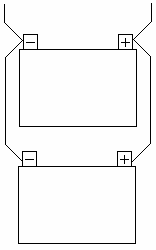 Next is wiring batteries in series. This is actually handy knowledge for those jumper cable welding trail repair moments. When hooking up two batteries in series, you hook the positive and negative together, then use the opposite posts on both batteries. Refer to the image below. This would give you 24 volts. Never do this with batteries in, or hooked up in your Jeep, you will fry your whole system. 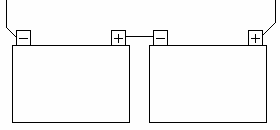 The biggest hurdle is the battery tray. You'd think fitting two batteries under the hood of a Jeep would be easy, but its not. You can buy or build or dual battery tray. If you choose to build a custom dual battery tray, you'll be amazed how many mount points the factory tray has. My factory YJ battery tray has 11 different mount points; I chose to re-use all 11 mount points as the combined weight of two Optimas is 90 pounds. Here are some pictures of my tray: 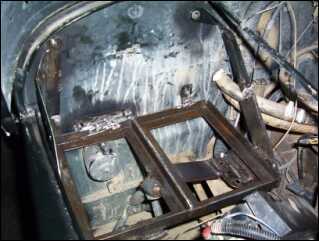 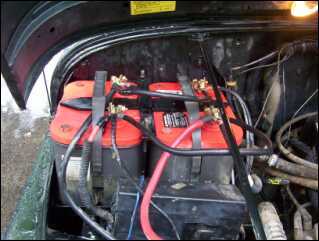 As for hook the batteries together you have several options. First use a real (expensive) dual battery kit. Usually these come with battery isolators that keep the second battery charged, but isolates it from the main battery until you flip the switch for the dual battery mode. Next some choose to use a dual battery switch similar to the one below: 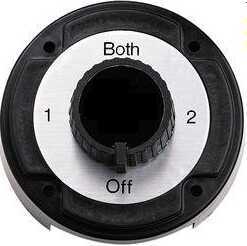 These switches can be bought as most any boat store, or you regular old auto parts store can usually get them too (Give them this Wells part number: SW1785 ). The battery switch allows you to use one battery or the other, or both, or completely disconnect both. The downside here is that you should every so often flip between the two to make sure they both stay fully charged. The third option is just to hook them together, no solenoids, and no fancy isolators, just run a cable between the two. This is the way most all large trucks on the road are wired. I ended up going this route, it's cheap and simple. The catch here is that one bad battery will take the other one with it, if you don't replace it in a timely manner as they aren't isolated. Also keep a few things in mind with a dual battery setup. Your setup is only as strong as its weakest battery. You batteries should be identical if possible. Ideally your cranking amps and reserve capacity should double when running dual batteries. If you have two 1000 cranking amp batteries each with a 100 minute reserve capacity, in a perfect world you would get 2000 cranking amps, with 200 minutes of reserve, however getting 75-80% of this is more likely. As for performance, usually a 34/78 OR RedTop Optima will hold 11.0-11.3 under a 900 amp load. Two Red Top Optimas will usually hold 11.4-11.5 under the same 900 amp load. The difference would be greater as the amp load increases but I didn't have a way to put more than a 900 amp load on the batteries. Trying to keep two batteries charged might give your factory alternator a work out, you may want to consider an alternator swap.
© Copyright 2006 - 2025 Mike Lee
|
|
|